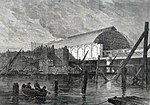Villiers Street

Villiers Street is a street in London connecting the Strand with the Embankment. It is partly pedestrianised; traffic runs northbound only up to John Adam Street, where vehicles must turn right. It was built by Nicholas Barbon in the 1670s on the site of York House, the property of George Villiers, Duke of Buckingham, whom the street commemorates. A watergate in nearby Embankment Gardens is the only remnant of the mansion and shows the original position of the north bank of the River Thames.John Evelyn lived here in the 17th century and the Irish writer Richard Steele, who founded The Spectator and The Tatler magazines, lodged here from 1712. The Charing Cross Hospital Medical School, now a part of the Imperial College Faculty of Medicine, was founded here in 1834. Prior to 1865, Villiers Street ran down the hill directly to a wharf by the river, known as Villiers Wharf. This was swept away in 1865 by the construction of the Victoria Embankment, with its sewers, and the District line railway. The river was moved back some 50 metres (164 ft) from the foot of Villiers Street.
Excerpt from the Wikipedia article Villiers Street (License: CC BY-SA 3.0, Authors, Images).Villiers Street
Northumberland Street, City of Westminster Covent Garden
Geographical coordinates (GPS) Address Nearby Places Show on map
Geographical coordinates (GPS)
| Latitude | Longitude |
|---|---|
| N 51.508 ° | E -0.1238 ° |
Address
Charing Cross Railway Station
Northumberland Street
WC2N 5DA City of Westminster, Covent Garden
England, United Kingdom
Open on Google Maps





